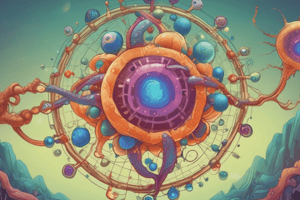Podcast
Questions and Answers
What is the main difference between the structure of DNA in prokaryotes and eukaryotes?
What is the main difference between the structure of DNA in prokaryotes and eukaryotes?
Prokaryotic DNA is circular, whereas eukaryotic DNA is linear.
Where is the DNA found in prokaryotic cells, and what is it associated with?
Where is the DNA found in prokaryotic cells, and what is it associated with?
The DNA is found in the cytoplasm (nucleoid) and is not associated with histones.
What is unique about the genes found in eukaryotic DNA compared to prokaryotic DNA?
What is unique about the genes found in eukaryotic DNA compared to prokaryotic DNA?
Eukaryotic genes contain introns.
How do the DNA molecules of mitochondria and chloroplasts compare to prokaryotic DNA?
How do the DNA molecules of mitochondria and chloroplasts compare to prokaryotic DNA?
What is the function of the DNA found in mitochondria and chloroplasts?
What is the function of the DNA found in mitochondria and chloroplasts?
What distinguishes proteins from polypeptides?
What distinguishes proteins from polypeptides?
What are the building blocks of proteins?
What are the building blocks of proteins?
What are essential amino acids?
What are essential amino acids?
What is the role of tRNA in protein synthesis?
What is the role of tRNA in protein synthesis?
What is the process of converting mRNA sequence into a specific sequence of amino acids?
What is the process of converting mRNA sequence into a specific sequence of amino acids?
What is the process of making a complimentary copy of a gene (DNA)?
What is the process of making a complimentary copy of a gene (DNA)?
What is the function of mRNA?
What is the function of mRNA?
How many essential amino acids are there?
How many essential amino acids are there?
What determines the function of a protein?
What determines the function of a protein?
What is the role of ribosomes in protein synthesis?
What is the role of ribosomes in protein synthesis?




